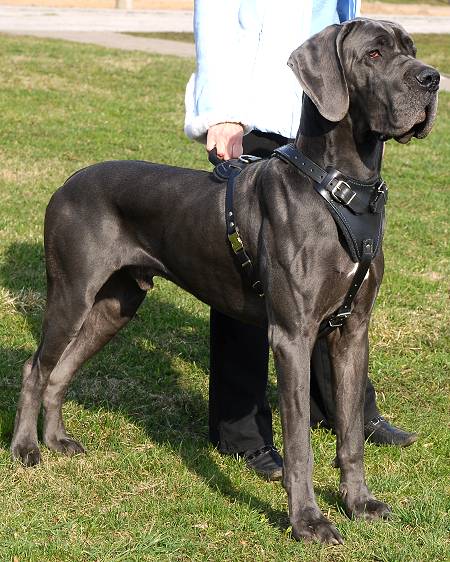Wednesday, January 14, 2009
The Great Dane Dog
Description :
The Great Dane is a giant dog that combines nobility with robustness and power with elegance. It has a long narrow head with an accentuated frontal stop and a rather large nasal canal. Its neck is long and muscular and its front legs are perfectly straight. It has muscular thighs and round feet with short, dark nails. The Great Dane's tail is medium-length, reaching to the point of the hock. Its eyes are round and usually dark - with a lively intelligent expression. Its ears are either cropped rather long, pointed, and carried erect, or left natural. Its well developed white teeth must close in a scissors bite. All Danes have short, thick, shiny, close-fitting hair. The color of the coat indicates the variety, fawn, brindle, black, blue, mantle harlequin and sometimes merle. Although not a recognized color, chocolate does occur in a recessive gene. Merle is a common result of harlequin breeding, but it is not a recognized color. Black coats and dark eyes, while blue Danes may have lighter eyes.
Temperament :
The Great Dane is a gentle giant. Dignified, kind, sweet and affectionate, it is playful and patient with children. It loves everyone and needs to be around people. The Great Dane does not bark much and only becomes aggressive when the circumstances require it. A steady dog, responsible and dependable. Brave and loyal, it is a good watchdog. Because of his giant size, the Great Dane should be thoroughly obedience trained when young so it will be manageable when fully grown. Teach this giant dog not to lean against people, especially children. The objective in training this dog is to achieve a pack leader status. It is a natural instinct for a dog to have an order in their pack. When we humans live with dogs, we become their pack. The entire pack cooperates under a single leader. Lines are clearly defined. You and all other humans MUST be higher up in the order than the dog. That is the only way your relationship can be a success. Dogs who know their place below humans in the pack order will be good with children. If you are not a firm, confident, consistent pack leader who knows how to correct the dog when he is showing signs of aggression, the dog can be dog-aggressive, especially with same sex dogs.
Height :
Dogs 30-34 inches (76-86 cm.) Bitches 28-32 inches (71-81 cm.)
Weight :
Dogs 120-200 pounds (54-90 kg.) Bitches 100-130 pounds (45-59 kg.)
Dogs of even larger size are more prized.
Health problems :
Not a long lived breed. Be careful to buy from a conscientious breeder, as some very poor specimens are being sold to the unsuspecting public. Beware of hip dysplasia; buy only from OFA certified stock. Also prone to bloat, tumors, heart disease, and tail injuries. Do not jog with this dog until it is at least one year old.
Living condition :
The Great Dane will do okay in an apartment if it is sufficiently exercised. It is relatively inactive indoors and does best with at least a large yard.
Exercises :
The Great Dane needs plenty of exercise. They need to be taken on a daily long walk.
Life expectancy :
The average is under 10 years, however some can live to be 12-13 years old.
Grooming :
The smooth short-haired coat is easy to groom. Comb and brush with a firm bristle brush and dry shampoo when necessary. Bathing this giant is a major chore, so it pays to avoid the need by daily grooming. The nails must be kept trimmed. This breed is an average shedder.
Origin :
Incised on some Greek money dating back to 36 B.C. is the image of a dog very similar to the Great Dane of today. The Great Dane is known as the "Apollo of all dogs." In 407 A.D. German Gaul and part of Italy and Spain were invaded by an Asiatic people (the Alans) who brought with them powerful mastiff-like dogs. In Germany especially, where these magnificent animals capable of overcoming bears and wild boars were much admired, a process of selective breeding was begun. The dogs were crossed with Irish Greyhounds, and the issue was the beautiful, large, thin, agile dog known today as the Great Dane. Despite the fact that they are called Danes in English, these dogs have nothing to do with Denmark. Some of the Great Dane's talents are tracking, watchdog and carting.
Subscribe to:
Post Comments (Atom)

No comments:
Post a Comment